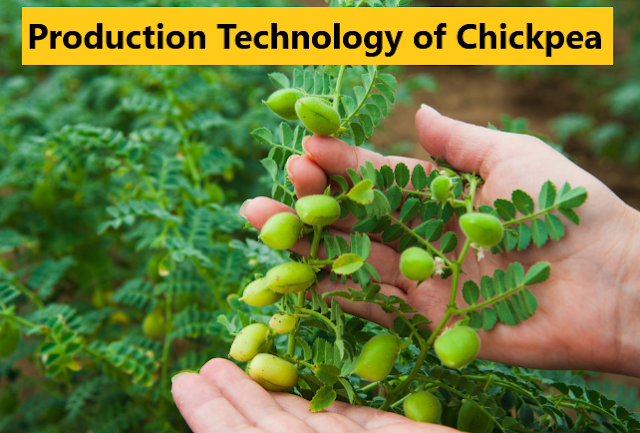New Update Production Technology of Chickpea
B.Sc.Ag. (Hons) Part-IV
 |
| Production Technology of Chickpea. https://cststudy.blogspot.com/ |
Production Technology of Chickpea
English name: Chickpea, Gram.
Scientific name: Cicer arietinum.
Family: Fabaceae.
Importance
Chick pea is one of the oldest pulse cash crops and cultivated throughout India Subcontinent since ancient times. Chickpea is popularly known as “Bengal Gram” (or) “Chana”. Chickpea is consumed as vegetable as well as fodder for livestock/animals. Chickpea can be made into split pulse (Chana Dal) and flour (besan). Variety of snacks, sweets and dishes can be made out of chickpea flour.
Variety
BARI chhola 2 (Boral), BARI chhola 3 (Varendro), BARI chhola 4 (Jora ful), BARI chhola 5 (Pabnai), BARI chhola 6 (Navarun), BARI chhola 7, BARI chhola 8, BARI chhola 9.
Climate
Chickpea crop grows well under good moisture conditions with ideal temperatures between 24º-30ºC. Chickpeas are cultivated under both irrigated and rainfed conditions. Basically chickpea is a cool season annual crop and prefers diurnal cycle of cool (17.8°-21°C) nights and warm (21°-26.7°C) days. This crop does not tolerate frost especially @ flowering stage as this will damage the seed development in the pod. Annually 65 to 95 cm rainfall is required for its cultivation. Excessive rains after sowing, flowering stage and seed maturity stage will result in heavy loss in crop yield.
Soil
Loam and clay loam soils are suitable for chickpea cultivation. It can be grown on soils having pH range of 6.0-9.0 although it is sensitive to salinity and alkalinity. Chickpea grows in fertile sandy loam and well drained soils.
Land Preparation
The land should be prepared by 3-4 Ploughing, cross ploughing with laddering.
Method of Sowing
Broadcasting and Line sowing can be done. For line sowing, Row to Row distance 40 cm.
Seed Rate
• Broadcasting: 50-60 kg/ha.
• Line sowing: 45-50 kg/ha.
Time of sowing
20 November – 10 December.
Fertilizer Application
Fertilizer Quantity/ ha
Urea 40-50 kg
TSP 80-90 kg
MoP 30-40 kg
Boric Acid 101-2 kg
Biofertilizer 5-6 kg
All fertilizer should be applied at final land preparation. Biofertilizer can be used 80 g/ kg of seed. If inoculum fertilizer applied then no need to application of Urea.
Irrigation
Chickpea can be cultivated mainly as rainfed crop. This crop requires light irrigations. Excessive watering should result in extra vegetative growth and reduces the yield of chickpea. If this crop is cultivated under irrigated condition, presowing irrigation is required for better germination of the seed. In case of no rains, give 1 irrigation @ preflowering, 1 irrigation @ flowering stage and 1 irrigation @ pod developing stage. Chickpea crop does not tolerate water stagnation in the field. Hence provide good internal drainage in the field.
Intercultural operation
Weed Control: Chickpea crop is more prone to infestation of weeds. Weed should be controlled at 30-35 days after emergence. 2nd weeding should be given after 2 months of sowing. Herbicides can also be used to control the weeds in chickpea crop. Apply preemergence fluchloralin 1 kg as basal/ha in 900 liters of water. It should be applied in the soil before sowing the seeds.
Pests and Diseases
▲ Cutworms and Pod Borer are main pests in chickpea farming.
Cutworms: To control this, apply Lindane 6% granules @ 2030 kg/ha mixed in the soil.
Pod Borer: To control this, apply spray of Endosulfan 35 EC @ 1.30 liters mixed in 900 1000 liters of water/ha.
▲ Wilt, Botrytis Grey Mold, Sclerotinia Blight, Rust and Ascochyta Blight are the main diseases in chickpea farming.
Wilt: This is mainly caused by fungus, Treating the seeds with a mixture of Benlate of Thiram (1:1) @ 2.5 g per kg of seed will control these diseases. Deep planting of seeds also control this to some extent.
Botrytis Grey Mold: Spraying the crop with 0.2% Bavistin will control this. Late sowing also reduces the chances of this disease.
Sclerotinia Blight: Choose healthy seeds and treat the field soil with a mixture Captan & Brassicol @ 12 kg per/ha to control this disease.
Rust: To control this disease in chickpea crop, spray the chickpea crop with 0.2% Mancozeb 75 WP followed by 2 more sprays @ 9 to 10 days interval. Choosing “Rust” resistant varieties will help in avoiding this type of disease.
Ascochyta Blight: To control this, follow the crop rotation and treat the seeds with Thiram or Bavistin @ 2.5 g/kg of seed before sowing.
Harvesting
Chickpea crop will be ready for harvesting after leaves turn reddishbrown and start shedding from the plant. Using sickle or hand, plants should be plucked. Should allow the crop to dry in sun for about a week and threshing should be carried out by beating the plants with sticks.
Yield
1.52 ton/ha.
If you can't understand something please comment below...



Comments
Post a Comment